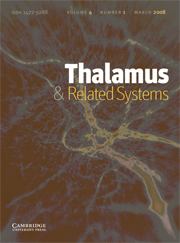Article contents
Thalamic oscillations modulate membrane properties of cat thalamic reticular neurons
Published online by Cambridge University Press: 11 October 2005
Abstract
Spindle oscillation is generated in intrathalamic circuits and thalamic reticular (RE) neurons act as pacemakers. To assess the consequences of this oscillation on membrane properties of RE neurons, we performed in vivo intracellular recordings in anesthetized cats during periods of intense synaptic activity, represented by spindle waves, compared to silent periods (interspindle lulls) that corresponded to a hyperpolarization of about −75 mV. During spindles, the massive activation of T-currents generated powerful low-threshold spikes (LTSs) that changed the membrane potential of RE cells by 10–20 mV and increased their membrane fluctuations by one order of magnitude (from 1–3 mV to 10 mV). Besides, the generation of LTSs decreased the apparent input resistance by ∼80% for ∼20–30 mseconds, in a cyclic way. The changes in basic membrane properties proved to be functionally significant for RE neurons, because both synaptic and intrinsic responsiveness were enhanced during active network states. Thus, synaptic responses tested by stimulating afferent (corticothalamic and thalamo-RE) pathways displayed increased spiking. The same result was found for intrinsic responses using positive and negative current pulses, and sinusoidal wave currents. Bursting discharges, responsible for the generation of the above changes, proved to be a very robust and reliable firing pattern in RE neurons. Our data demonstrate that ongoing network activity of RE neurons during spindle oscillations influence the expression of intrinsic properties of these pacemaking neurons, similarly to the previously shown effect exerted by spontaneously occurring synaptic activity on the intrinsic properties of thalamocortical and neocortical neurons.
- Type
- Research Article
- Information
- Copyright
- © 2005 Cambridge University Press
- 1
- Cited by


